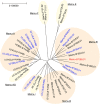Lipopeptides: a novel antigen repertoire presented by major histocompatibility complex class I molecules
- PMID: 27402593
- PMCID: PMC5011682
- DOI: 10.1111/imm.12646
Lipopeptides: a novel antigen repertoire presented by major histocompatibility complex class I molecules
Abstract
Post-translationally modified peptides, such as those containing either phosphorylated or O-glycosylated serine/threonine residues, may be presented to cytotoxic T lymphocytes (CTLs) by MHC class I molecules. Most of these modified peptides are captured in the MHC class I groove in a similar manner to that for unmodified peptides. N-Myristoylated 5-mer lipopeptides have recently been identified as a novel chemical class of MHC class I-presented antigens. The rhesus classical MHC class I allele, Mamu-B*098, was found to be capable of binding N-myristoylated lipopeptides and presenting them to CTLs. A high-resolution X-ray crystallographic analysis of the Mamu-B*098:lipopeptide complex revealed that the myristic group as well as conserved C-terminal serine residue of the lipopeptide ligand functioned as anchors, whereas the short stretch of three amino acid residues located in the middle of the lipopeptides was only exposed externally with the potential to interact directly with specific T-cell receptors. Therefore, the modes of lipopeptide-ligand interactions with MHC class I and with T-cell receptors are novel and fundamentally distinct from that for MHC class I-presented peptides. Another lipopeptide-presenting MHC class I allele has now been identified, leading us to the prediction that MHC class I molecules may be separated on a functional basis into two groups: one presenting long peptides and the other presenting short lipopeptides. Since the N-myristoylation of viral proteins is often linked to pathogenesis, CTLs capable of sensing N-myristoylation may serve to control pathogenic viruses, raising the possibility for the development of a new type of lipopeptide vaccine.
Keywords: antigen presentation/processing; major histocompatibility complex; structural biology/crystallography.
© 2016 John Wiley & Sons Ltd.
Figures



References
-
- Neefjes J, Jongsma ML, Paul P, Bakke O. Towards a systems understanding of MHC class I and MHC class II antigen presentation. Nat Rev Immunol 2011; 11:823–36. - PubMed
-
- Van Kaer L, Ashton‐Rickardt PG, Ploegh HL, Tonegawa S. TAP1 mutant mice are deficient in antigen presentation, surface class I molecules, and CD4–8+ T cells. Cell 1992; 71:1205–14. - PubMed
-
- Harty JT, Bevan MJ. Responses of CD8+ T cells to intracellular bacteria. Curr Opin Immunol 1999; 11:89–93. - PubMed
Publication types
MeSH terms
Substances
LinkOut - more resources
Full Text Sources
Other Literature Sources
Medical
Research Materials
Miscellaneous

